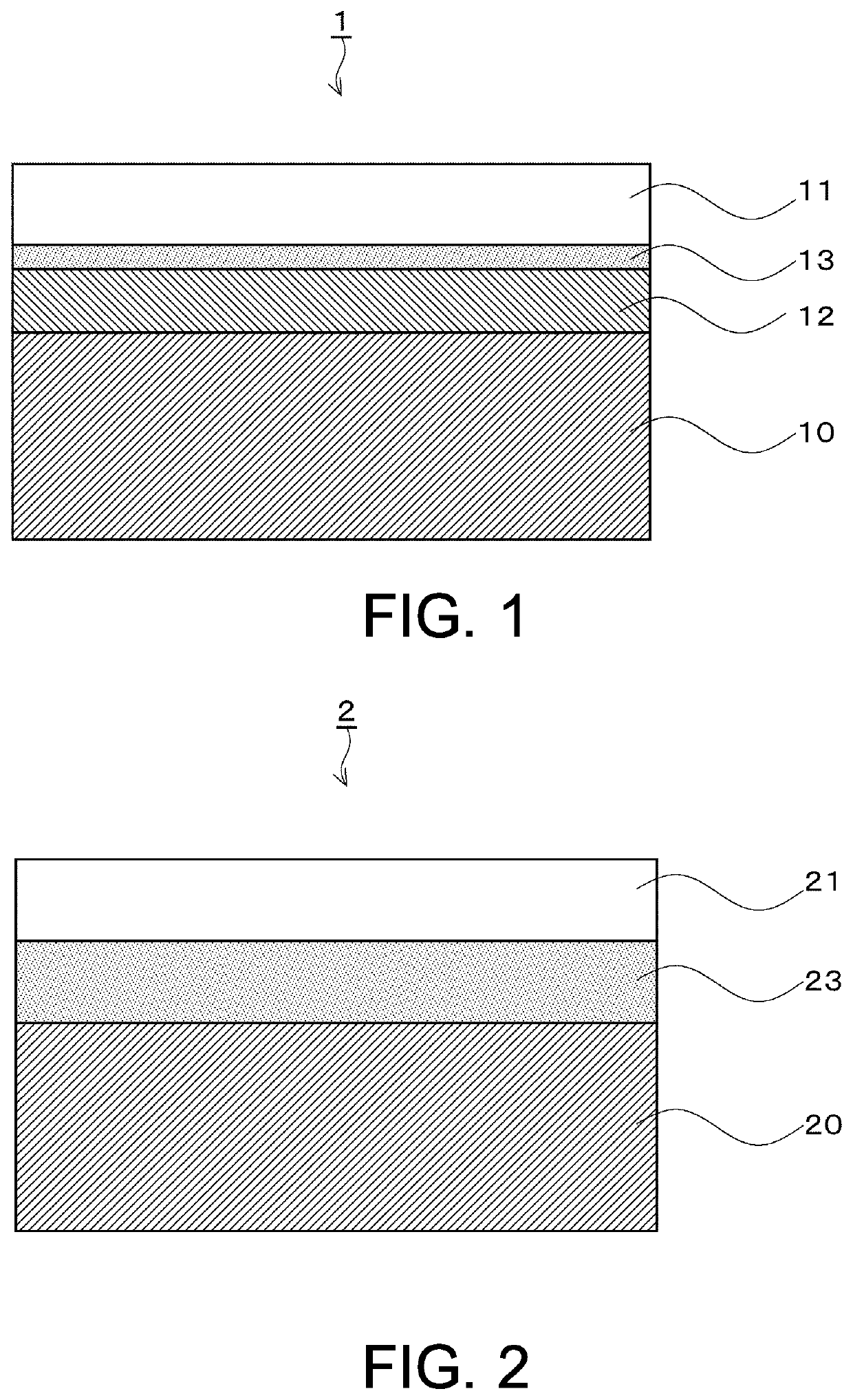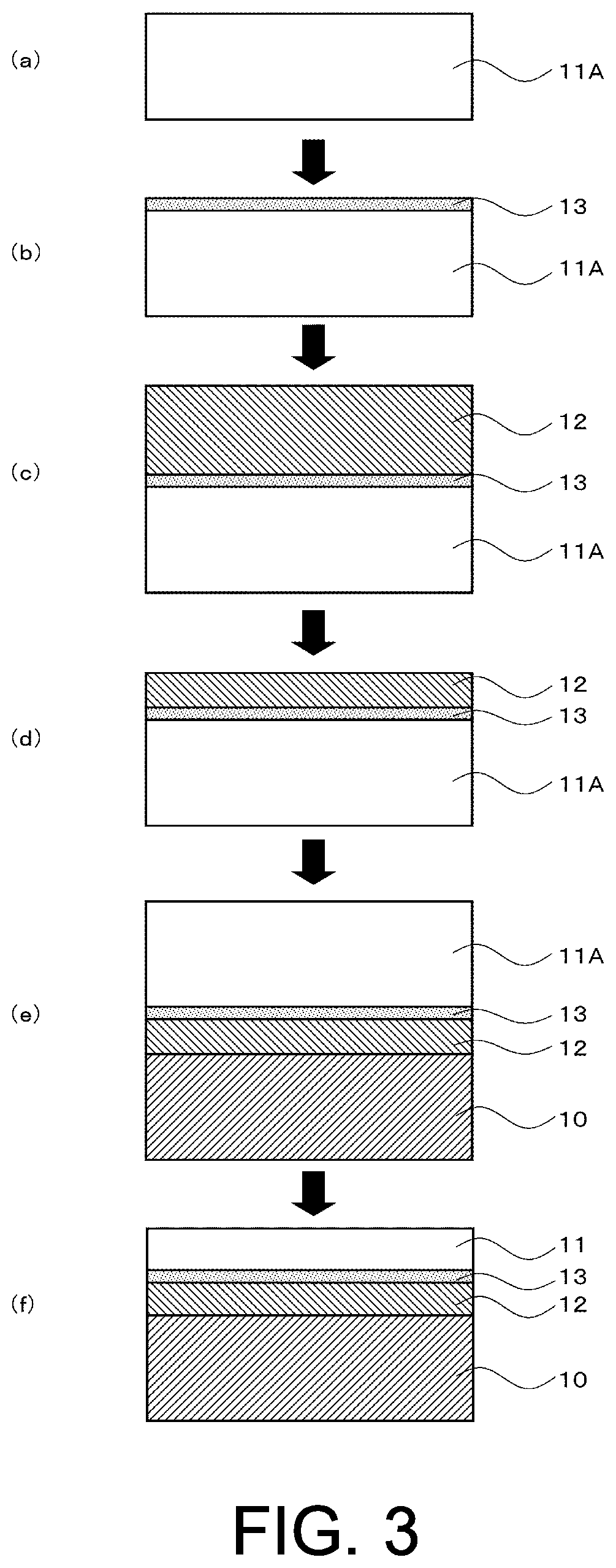Composite substrate and method of manufacturing composite substrate
a technology of composite substrates and substrates, applied in the direction of impedence networks, electrical devices, etc., can solve the problems of increasing resistance of lt (or ln) layers, pyroelectric, and reducing the yield of device manufacturing processes, so as to suppress the increase in pyroelectricity caused by heat-treatment processes
- Summary
- Abstract
- Description
- Claims
- Application Information
AI Technical Summary
Benefits of technology
Problems solved by technology
Method used
Image
Examples
example 1
[0035]Approximately 25 nm of SiN was deposited on one side of an LT wafer with a diameter of 150 mm by the PVD method to form a diffusion prevention layer. Then, a silicon oxide film was formed on this diffusion prevention layer by CVD to a thickness of about 3 μm. The silicon oxide film was polished and bonded to a p-type silicon wafer with a resistivity of 2000 Ωcm using this silicon oxide film as an intervening layer. The LT wafers used are highly conductive, with bulk conductivity of about 4×10−11 / Ωcm. After the bonding, heat treatment was applied in a nitrogen atmosphere at 100° C. for 48 hours. The LT layer was then thinned by grinding and polishing to a thickness of 20 μm. Then, to further increase the bonding strength, heat treatment was performed at 250° C. for 24 hours in a nitrogen atmosphere.
[0036]The pyroelectricity of the bonded substrate manufactured as described above was evaluated by surface potential. The bonded substrate was placed on a hot plate at 250° C. for 20...
example 2
[0039]Approximately 25 nm of SiN was deposited on one side of an LT wafer with a diameter of 150 mm by the PVD method to form a diffusion prevention layer. Then, a silicon oxide film was formed on this diffusion prevention layer by CVD to a thickness of about 3 μm. The silicon oxide film was polished and bonded to a p-type silicon wafer with a resistivity of 2000 Ωcm using this silicon oxide film as an intervening layer. Prior to the bonding, the bonding surface was surface activated by the plasma activation method. The LT wafers used are highly conductive, with bulk conductivity of about 4×10−11 / Ωcm. After the bonding, heat treatment was applied in a nitrogen atmosphere at 100° C. for 48 hours. The LT layer was then thinned by grinding and polishing to a thickness of 20 μm. Then, to further increase the bonding strength, heat treatment was performed at 250° C. for 24 hours in a nitrogen atmosphere.
[0040]The pyroelectricity of the bonded substrate manufactured as described above was...
examples 3 , 4
Examples 3, 4
[0041]Approximately 25 nm of SiN diffusion prevention film was deposited on one side of an LT wafer with a diameter of 150 mm by the PVD method to form a diffusion prevention layer. Then, a silicon oxide film was formed on this diffusion prevention layer by CVD to a thickness of about 3 μm. The silicon oxide film was polished, and after surface activation, bonded to a p-type silicon wafer with a resistivity of 2000 Ωcm using this silicon oxide film as an intervening layer. Prior to the bonding, the bonding surface was surface activated by various activation methods (ion beam activation method, ozone water activation method). The LT wafers used are highly conductive, with bulk conductivity of about 4×10−11 / Ωcm. After the bonding, heat treatment was applied in a nitrogen atmosphere at 100° C. for 48 hours. The LT layer was then thinned by grinding and polishing to a thickness of 20 μm. Then, to further increase the bonding strength, heat treatment was performed at 250° C....
PUM
| Property | Measurement | Unit |
|---|---|---|
| diameter | aaaaa | aaaaa |
| diameter | aaaaa | aaaaa |
| thickness | aaaaa | aaaaa |
Abstract
Description
Claims
Application Information
 Login to View More
Login to View More - R&D
- Intellectual Property
- Life Sciences
- Materials
- Tech Scout
- Unparalleled Data Quality
- Higher Quality Content
- 60% Fewer Hallucinations
Browse by: Latest US Patents, China's latest patents, Technical Efficacy Thesaurus, Application Domain, Technology Topic, Popular Technical Reports.
© 2025 PatSnap. All rights reserved.Legal|Privacy policy|Modern Slavery Act Transparency Statement|Sitemap|About US| Contact US: help@patsnap.com


